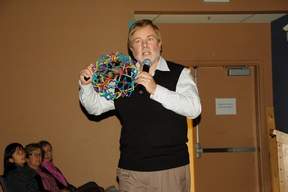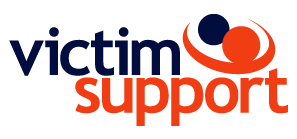News & Announcements
- Details
- Written by Laura Mirsky
 “Somebody could have died that day.” That’s what a student said after a fight nearly erupted at a small Detroit high school last month. But a restorative circle squashed the tension and prevented a tragedy.
“Somebody could have died that day.” That’s what a student said after a fight nearly erupted at a small Detroit high school last month. But a restorative circle squashed the tension and prevented a tragedy.
It began in the cafeteria with an argument between two boys, but it quickly escalated, with kids taking sides, stripping off their shirts and getting into it. With some of the students claiming past affiliation with a neighborhood gang, this was serious.
The adults tried to separate the boys, but they struggled to calm the two students down.
Then a ninth grade boy stepped in: “I got this. I’ll do a circle.”
- Details
- Written by Joshua Wachtel
 Si Lewen is an amazing, now 93-year-old, artist who donated his entire catalog of life's work to IIRP to be used to promote IIRP's mission. There is much that can be said about Si, but for the moment I just want to offer a link to his web site and suggest that readers enjoy a stroll through his on-line gallery. Enjoy and please comment!
Si Lewen is an amazing, now 93-year-old, artist who donated his entire catalog of life's work to IIRP to be used to promote IIRP's mission. There is much that can be said about Si, but for the moment I just want to offer a link to his web site and suggest that readers enjoy a stroll through his on-line gallery. Enjoy and please comment!
- Details
- Written by Joshua Wachtel
Tuesday, November 28 is the last chance to book a place at this seminar in London on December 1st from noon to 5pm:
Independent Academic Research Studies and the Restorative Justice Council are pleased to invite you to a joint half-day seminar.
The seminar will launch the IARS report "Restorative Justice and the Secure Estate: Alternatives for Young People."
The report is based on a three year research programme that looked at the use of restorative justice practices in prisons. The fieldwork was carried out in the UK with a particular focus on young people in custody. The event and the IARS report is part of the "Mediation and Restorative Justice in Prison Settings" project MEREPS.
- Details
- Written by Joshua Wachtel
 Illustration from Cooperative GrocerHere's a lovely article by Jennifer Crain for Cooperative Grocer, a trade publication for food cooperatives in North America, about a food market in Olympia Washington that operates on consensus and "decided to revamp its staff accountability" to "include the adoption of restorative practices."
Illustration from Cooperative GrocerHere's a lovely article by Jennifer Crain for Cooperative Grocer, a trade publication for food cooperatives in North America, about a food market in Olympia Washington that operates on consensus and "decided to revamp its staff accountability" to "include the adoption of restorative practices."
Before the Olympia Food Co-op became a two-store operation with over 80 staff members, resolving internal conflicts was a direct but mostly informal process. If a conflict arose, such as an abrasive interaction, lateness or worker negligence, any staff member of the consensus-run collective could give direct feedback to the offending co-worker, either face-to-face or in an evaluation.
- Details
- Written by Joshua Wachtel
I'm pleased to reprint this article by Ben Ingram about a presentation given at a school by Bruce Schenk, director of IIRP Canada.
 Bruce Schenk uses a Hoberman sphere to illustrate the benefit of helping offenders to feel apologetic instead of threatened, to learn from their actions and not only be punished for them. Photo by Ben IngramA Nov. 10 presentation at Chatelech Secondary School in Sechelt discussed the benefits of adopting a restorative approach to conflict resolution in both the community and its schools.
Bruce Schenk uses a Hoberman sphere to illustrate the benefit of helping offenders to feel apologetic instead of threatened, to learn from their actions and not only be punished for them. Photo by Ben IngramA Nov. 10 presentation at Chatelech Secondary School in Sechelt discussed the benefits of adopting a restorative approach to conflict resolution in both the community and its schools.
The idea behind restorative justice is to bring together offenders and those affected by their actions in a healing environment in favour of a punitive one. Proponents say the method can strengthen the community as a whole.
As a director for the International Institute for Restorative Practices, Bruce Schenk said he’d seen the impacts of the approach and its growing popularity.
- Details
- Written by Joshua Wachtel
 In Nova Scotia, where IIRP held its 14th International Conference in June, the province celebrated 10 years of success with restorative justice programs during national restorative justice week, Nov. 13-20. The province has developed a very widely integrated approach to RJ. In her welcome address at the Halifax conference, Jennifer Llewellyn noted, "After a successful pilot that began in 1999, the program has been fully operational since 2001. The past 10 years has seen the program develop through a robust partnership between government and community throughout the Province. The program is accessible to young people 12 to 17 years of age at all stages of the criminal justice process. "
In Nova Scotia, where IIRP held its 14th International Conference in June, the province celebrated 10 years of success with restorative justice programs during national restorative justice week, Nov. 13-20. The province has developed a very widely integrated approach to RJ. In her welcome address at the Halifax conference, Jennifer Llewellyn noted, "After a successful pilot that began in 1999, the program has been fully operational since 2001. The past 10 years has seen the program develop through a robust partnership between government and community throughout the Province. The program is accessible to young people 12 to 17 years of age at all stages of the criminal justice process. "
Justice Minister Ross Landry said the programs allow offenders to take responsibility for their crimes and help bring closure for victims.
- Details
- Written by Joshua Wachtel
Today I'm reposting a comment by IIRP professor Alia Sheety in response to Lisa Rea's commentary (read the original post here) regarding the ongoing Penn State sexual abuse story.
I totally agree with the need to ask different questions. I also believe that through the media we could bring others to the awareness of asking different questions.
As we witness in this case, a punitive approach was adopted. Still, what bothered me most is ignoring the needs of the victims. Thanks for remembering the victims' needs and for bringing this forward. It is time to respond to those needs – even 15 years later.
- Details
- Written by Joshua Wachtel
 It looks like the Restorative Justice Council's Practitioners Register is growing. To view the register click here. There appear to be about 20 accredited members and another 40 or so associate members. Associate membership is open to anyone who agrees to the RJC Practitioner Code of Practice. This document states:
It looks like the Restorative Justice Council's Practitioners Register is growing. To view the register click here. There appear to be about 20 accredited members and another 40 or so associate members. Associate membership is open to anyone who agrees to the RJC Practitioner Code of Practice. This document states:
Restorative Processes bring those harmed by crime and conflict, and those responsible for the harm, into communication, enabling everyone affected by a particular incident to play a part in repairing the harm and finding a positive way forward.
- Details
- Written by Joshua Wachtel
From Nova Studios web site:
- Details
- Written by Joshua Wachtel
Lisa Rea has this opinion piece today at RJOnline which highlights a need for the media to start asking different questions which could ultimately have a bearing on our legal system.
 As the story comes out in more detail about the alleged sexual abuse of children by Jerry Sandusky, former assistant football coach at Penn State, the coverage of the story seems to be more about the actions of veteran coach Joe Paterno--his resignation or the university's decision to fire him.
As the story comes out in more detail about the alleged sexual abuse of children by Jerry Sandusky, former assistant football coach at Penn State, the coverage of the story seems to be more about the actions of veteran coach Joe Paterno--his resignation or the university's decision to fire him.

Restorative Works Year in Review 2023 (PDF)
All our donors are acknowledged annually in Restorative Works.
